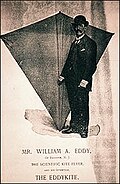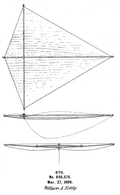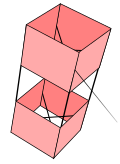Especialidades JA/Cometas/Respuestas
| Cometas | ||
|---|---|---|
| Asociación General
|
Destreza: 1 Año de introducción: 1986 |
|
Requisitos
|
La especialidad de Cometas es un componente de la Maestría Recreación. |
1
2
Kites are used today for the following:
- Predicting weather (carrying aloft meteorological instruments).
- Carrying loads of water ?
- Spaceflight (during the recovery of space vehicles)
- Pulling ships at sea
- Recreation (kite surfing and skateboarding)
3
4
4a
4b
4c
4d
4e
4f
4g
4h
4i
4j
4k
4l
5
- Lack of wind.
- Too strong a wind.
- Trees or other obstacles causing turbulence.
- Essential parts of the kite or line breaking (e.g., too powerful a wind can break spars or the kite string).
6
The usual causes of a kite looping are:
- Not enough di-hedral.
- Poorly bridled.
- Poorly balanced.
- Too much wind.
If the kite starts to misbehave when already aloft the problem is most likely to be too much wind. Release tension on the line and try to pull the kite diagonally out of the wind-window and closer to you. The closer you have it, the more control of it you will have too. Most importantly you must keep the kite under your control.
7
A kite's tail is used to add stability to the kite and keep it facing into the wind. If there is enough di-hedral this will then prevent the kite from looping. The length of a tail should be from six to nine times the length of the kite body. Some put them on the kite so that when in the air it will wave along the wind - for decoration.
8
9
9a
9b
10
Adventist Youth Honors Answer Book/Knot/Fisherman's bend
10a
10b
10c
10d
By adding yet another spine and another keel, plus a strip of material between the kite is now called Delta Conyne.
- External Site to make Delta Conyne Wing Kite - http://www.kitemonger.com/kiteplan/sbd/index.html
10e
The Malay kite is a model of tailless kite. First introduced to the West in a New York newspaper article from October 1894, the Malay kite was used for recreation for centuries before this in parts of the Far East. The article detailed how a university professor ("Clayton") had erected a series of kites and bound them all together to one kite. These kites had no tail, were bowed and diamond shaped, and were referred to by the article writer as "Malay kites". However, the existence of a Malay-like design may have already been heard of in the United States sometime before the publishing of the article; in the last edition of the American Boy's Handy Book, another tailless kite is described (there referred to as a "Holland" kite). The description of this kite, which was to be included as a chapter in the book, was sent in to the author sometime around 1882, eleven years before the Malay kite was mentioned in the newspaper. Note:- to make the 'Malay' or 'Eddy' kite fly "tail less" dihedral is applied to the kite by fitting a bowline to the cross spar in like manner to that used on the Eddo, Korean, and Rocacoo. The pre-application of bow onto the cross spar is the main difference between the classic diamond and the Eddy. The other difference is that the bow enables the Eddy to fly without a tail. which the classic 'Diamond' requires.
10f
A box kite is a high-performance kite, noted for developing relatively high lift. The typical design has four parallel struts. The box is made rigid with diagonal crossed struts. There are two sails, or ribbons, whose width is about a quarter to one third of the length of the box. The ribbons wrap around the ends of the box, leaving the ends and middle of the kite open. In flight, one strut is the bottom, and the bridle is tied between the top and bottom of this strut. The dihedrals of the sails help stability. Note:- The central gap between the sails is essential, as the air flow passing around both the inside and outside of the rear 'ribbon' has a stabalising effect and seems to give the kite more 'lift' or elevation.
- This one's a bit involved - http://www.howtomakeandflykites.com/kites-to-make/the-box-kite.html
10g
A tetrahedral kite is a multi-celled rigid box kite composed of tetrahedrally shaped cells. The cells are usually arranged in such a way that the entire kite is also a regular tetrahedron. The kite can be described as a compound dihedral kite as well.
This kite was created by Alexander Graham Bell. It came about from his experiments with Hargrave's Box Kites and his attempts to build a kite that was big enough to carry both a man and a motor. Bell wrote about his discovery of this concept in the National Geographic June 1903 issue; the article was titled "Tetrahedral Principle in Kite Structure".
This style kite, while not an easy kite to make compared to the simple cross kite, is a very stable kite and is easy to fly. It flies well in moderate to heavy winds if it is properly set up.
- http://www.instructables.com/id/Tetrahedral-Kite/
- http://www.cit.gu.edu.au/~anthony/kites/tetra/straw_plan/
References
- Categoría: Tiene imagen de insignia
- Categoría:Libro de Respuestas de Especialidades JA/Especialidades
- Categoría:Libro de Respuestas de Especialidades JA
- Categoría:Libro de Respuestas de Especialidades JA/Nivel de Destreza 1
- Categoría: Libro de respuestas de especialidades JA/Especialidades introducidas en 1986
- Categoría:Libro de Respuestas de Especialidades JA/Asociación General
- Adventist Youth Honors Answer Book/Recreation/es
- Adventist Youth Honors Answer Book/Recreation/Primary/es
- Categoría:Libro de Respuestas de Especialidades JA/Etapa 0
- Adventist Youth Honors Answer Book/Recreation Master Award/es
- Adventist Youth Honors Answer Book






